Máy 5 Đầu Lọc (Five-Staged, NSF Certified Reverse Osmosis Water Filter) [RO-ERO-550]
- NSF Certified. Required a special wrech to change filters.
- Click here for replacement filters.
*** ALKALINE Filter: Add $90 - Natural Alkaline Mineral Enriched Water (unless you want to spend $4,000 system)
- Hình Sản Phẩm:
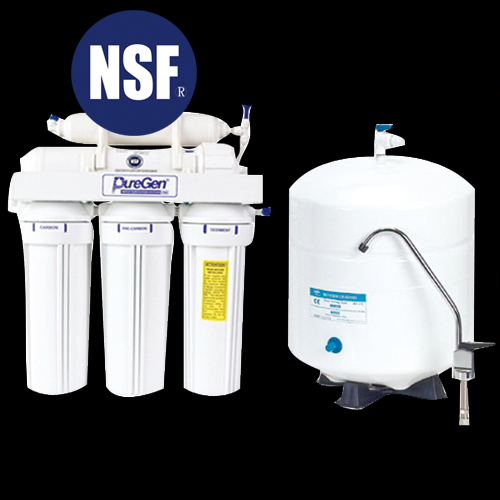
1. Why do we need a Reverse Osmosis Water Filter? [ How does it work? ]
Nước có nhiều Chlorine, có mùi rất khó uống, hơn nữa khi dùng Water Softener, không ít thì nhiều có muối trong nước, cho nên cần phải có RO Water Filter gắn dưới sink để uống và nấu ăn. Với hệ thống này, không cần phải đi mua nước chai, hay nước lọc. Vào trang nầy, đọc thêm về "quy trình xử lý nước uống tinh khiết theo công nghệ R.O."
In addition, other contaminants (review Water Quality Report) that a reverse osmosis water filter can remove includes the following (just a partial list):
|
arsenic (pentavalent) |
asbestos | barium |
| benzene | cadmium | copper |
| chlorine taste and odor | cysts | fluoride |
| haloacetic acids (HAA5's) | lead | magnesium |
| nitrates and nitrites |
parasites like cryptosporidium |
radium |
| sodium |
perfluorochemicals (PFC's) |
selenium |
| tannin | TDS (total dissolved solids) | sulfate |
| Volatile Organic Chemicals (VOC's) | trihalomethanes (TTHM's) | zinc |
2. What are included?
1. Filter #1- 5 Micron Sediment Filter: reduce dirt, sand and rust that cause cloudy water
2. Filter #2- 5 Micron Carbon Block Filter: absorb Chlorine taste and ordor
3. Filter #3- Post-Carbon Filter: ensure your drinking water is clear and fresh
4. Filter #4- R.O. Membrane Filter: reduce dissolved substances such as radium, lead, and other unwanted impurities
5. Filter #5- GAC in-line filter: enhance water's taste (GAC: Granular Activated Carbon: than hoạt tính)
6. Water Tank (thêm $30 cho brush nickle faucet)
3. Cost of filter replacement: Usually, we change filters every 6 month, R.O. membrane in 1-2 years.
$8+ $8 + ($45 membrance) +$8 + ($10 in-line) >>> about $24 for filter replacement.
4. Other brands: You can buy a Watts Premier 5SV in Costco for $199 + Tax. However, you need to know cost for filter replacement [ $15.95 + $9.95 + $9.95 + ($99) + $15.50 + Tax + S&H, ~$50-$60 for every 6-month ]
Therefore, with about $30 more, buy this PureGen 5-Staged RO Water Filter, better with 5 stages, và có lợi hơn trong tương lai. Spend $21 for filter replacement. KB Home installed a 1/4" tube from under sink to the fridge. You can buy a "Fridge filter by-pass plug" to plug this, not to use fridge filter which costs $50 for replacement every 6-month. In addition, 5 filters (5-stages) R.O. is better than 1 filter in the fridge.
Khi tham khảo, nhớ hỏi rõ là máy có mấy đầu lọc (3, 4, hay 5 stages), giá thay filters là bao nhiêu, giá thay membrane là bao nhiêu mới có thể so sánh "apple-to-apple" được.
System.String[]System.String[]
Máy "Water Softener" làm việc như thế nào? (How it works)
It makes hard water easy to get along with.
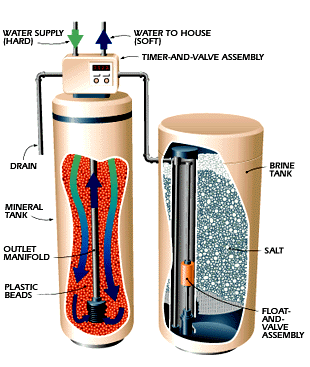 It's easy to forget how important water is in our lives. Of course we need it in our diet, but in our homes, it's a tool--a fluid medium that carries material from one place to the next. And one of the reasons it does this job well is that it's very good at holding things, either by suspending them or dissolving them.
It's easy to forget how important water is in our lives. Of course we need it in our diet, but in our homes, it's a tool--a fluid medium that carries material from one place to the next. And one of the reasons it does this job well is that it's very good at holding things, either by suspending them or dissolving them.
Unlike most tools, though, water doesn't come with an instruction manual. If it did, you'd know why the dishes you thought were washed are covered with spots when dry, why the water in your shower leaves a film on everything it touches, and why what you thought was clean water has clogged up your plumbing system.
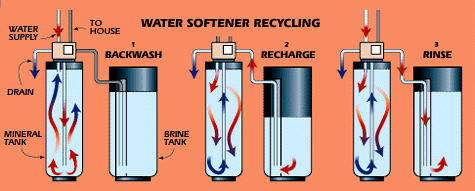
The Solution Is The Problem
While water is in the ground, it picks up soluble bits of whatever it passes through. While this can mean contamination that makes the water unfit to drink, in many cases it simply means that the water contains minerals found in the earth. Of these, calcium and magnesium are of particular importance because they affect the water's ability to function in our homes. These minerals make our water hard.
One effect of hard water is that soaps and detergents lose some effectiveness. Instead of dissolving completely, soap combines with the minerals to form a coagulated soap curd. Because less soap is dissolved, more is required. And the sticky insoluble curd hangs around--it clings to the skin and may actually inhibit cleansing. Washed hair seems dull and lifeless.
In the laundry, things aren't much better. The soap curd can work its way into your clothes as they're being washed in your automatic washing machine. This can keep dirt trapped in the fibers, and it can stiffen and roughen the fabric.
In addition to affecting the actual washing process, insoluble soap deposits leave spots on everything you wash--from your dishes to the family car--and a soap film will build up in your bath and shower.
Another reason to be concerned about hard water is its effect on your plumbing system. Calcium and magnesium deposits can build up in pipes, reducing flow to taps and appliances. In water heaters, these minerals generate a scale buildup that reduces the efficiency and life of the heater.
The Fix
The solution to the problem is to get rid of the calcium and magnesium. While there are chemical treatments that do this, the most popular answer is a water softener.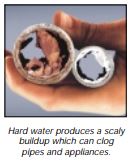
The typical water softener is a mechanical appliance that's plumbed into your home's water supply system. All water softeners use the same operating principle: They trade the minerals for something else, in most cases sodium. The process is called ion exchange.
The heart of a water softener is a mineral tank. It's filled with small polystyrene beads, also known as resin or zeolite. The beads carry a negative charge.
Calcium and magnesium in water both carry positive charges. This means that these minerals will cling to the beads as the hard water passes through the mineral tank. Sodium ions also have positive charges, albeit not as strong as the charge on the calcium and magnesium. When a very strong brine solution is flushed through a tank that has beads already saturated with calcium and magnesium, the sheer volume of the sodium ions is enough to drive the calcium and magnesium ions off the beads. Water softeners have a separate brine tank that uses common salt to create this brine solution.
In normal operation, hard water moves into the mineral tank and the calcium and magnesium ions move to the beads, replacing sodium ions. The sodium ions go into the water. Once the beads are saturated with calcium and magnesium, the unit enters a 3-phase regenerating cycle. First, the backwash phase reverses water flow to flush dirt out of the tank. In the recharge phase, the concentrated sodium-rich salt solution is carried from the brine tank through the mineral tank. The sodium collects on the beads, replacing the calcium and magnesium, which go down the drain. Once this phase is over, the mineral tank is flushed of excess brine and the brine tank is refilled.
The Brains
Most popular water softeners have an automatic regenerating system. The most basic type has an electric timer that flushes and recharges the system on a regular schedule. During recharging, soft water is not available.
A second type of control uses a computer that watches how much water is used. When enough water has passed through the mineral tank to have depleted the beads of sodium, the computer triggers regeneration. These softeners often have reserve resin capacity, so that some soft water will be available during recharging.
A third type of control uses a mechanical water meter to measure water usage and initiate recharging. The advantage of this system is that no electrical components are required and the mineral tank is only recharged when necessary. When it is equipped with two mineral tanks, softened water is always available, even when the unit is recharging.
Judging Water Hardness
Companies that sell water softening equipment generally offer test kits that help you determine the hardness of your water. For commercial testing sources, check your Yellow Pages under "water analysis."
Water hardness is measured in grains per gallon (GPG) or milligrams per liter (mg/l, equivalent to parts per million, or ppm). Water up to 1 GPG (or 17.1 mg/l) is considered soft, and water from 60 to 120 GPG is considered moderately hard. A water softener's effectiveness depends on how hard the incoming water is. Water over 100 GPG may not be completely softened.
Health Concerns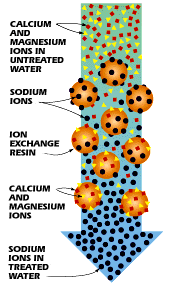
Hard water poses no health hazard. On the other hand, the sodium that remains in softened water may be a problem for those on sodium-restricted diets. Other people simply may wish to avoid the slightly salty taste of treated water. In either case you can install a separate water dispenser that bypasses the softener. You also can use potassium chloride instead of salt, although this costs about three to four times more.
Source: http://www.popularmechanics.com/home/interior-projects/how-to/a150/1275126/
###
#188
MÁY Water Softener Cabinet: 14"W x 21"D x 45"H (cabinet Compact Unit, 1.5 CuFt of Resin)
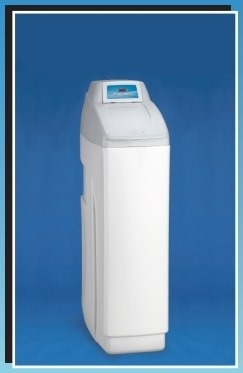
|
Residential Water Softener Eliminates limescale, soapcurd and reduces Soap/Detergent use up to 70%. |
||||||||||||||||||||||||
|
||||||||||||||||||||||||
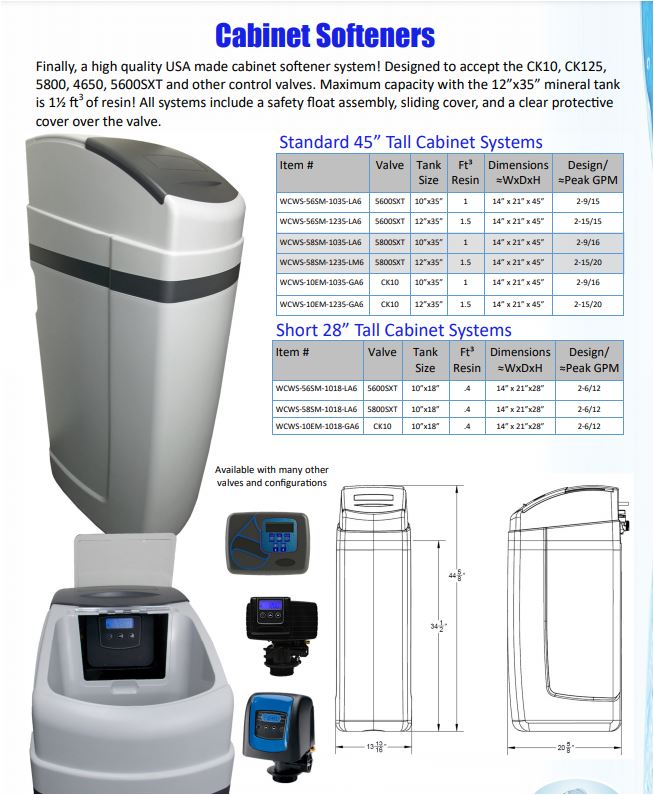
#187
[ How does it work? ] [ How to size a correct water softener? ] 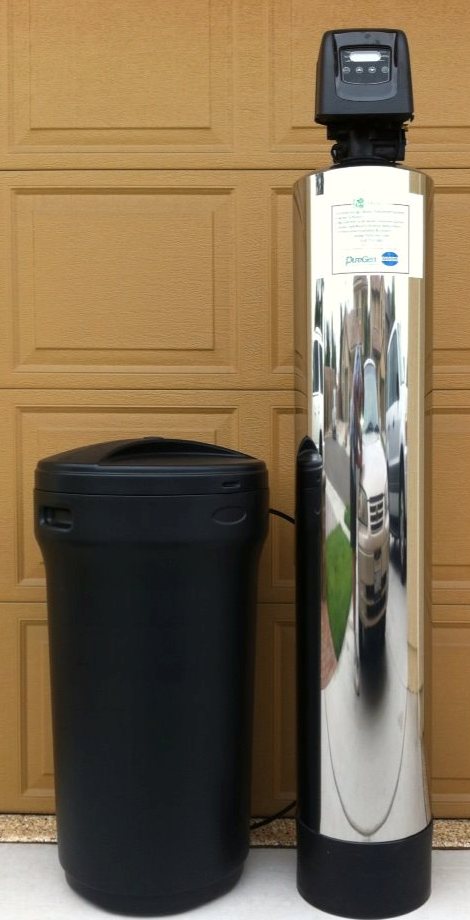
-
1.0 Cubic Feet of High Capacity Purolite C-100E Resin (32,000 grains capacity @ 15-lb salt setting)
-
9"x44" vessel; 3 colors to choose from black, blue, or almond (like Culligan)
-
Add $75 for a stainless steel jacket with a plastic cap (as shown) or $100 for fully welded stainless steel jacket)
-
Suggest to be installed with a Whole House Carbon Filter (System #10) to completely reduce the objectionable taste and odors of Chlorine in City water for better taste and smell.
-
PureGen provides 1-year warranty for the entire system
- 714water.com provide 1-year warranty on labor. See "Warranty" page for more information.
-
5-year warranty for Fleck Control Valve by Pentair Water or Clack Control Valve by Clack Corporation
-
10-year warranty for pressure vessels by Structural Pentair Water
-
Water Softeners require electricity, salt, and drain to a sewer system.
Benefits of Water Softeners:
-
Review this flyer on Water Softeners' benefits
-
Soft water versus hard water has many benefits. Like clean shiny silverware and glassware. No one likes the spotty chalky hard water spots on their silverware, glasses or dishes.
-
Since shampoos, soaps and detergents do not lather well in hard water, naturally soft water or hard water made soft through a water softener restores the rich lathering cleaning ability and cuts down on the usage and costs of soaps and detergents by 75%. Also, one can return to natural chemical free healthy soaps and laundering agents. The harsh chemicals in nowaday soaps and detergents were invented to combat hard water and still have some lather. With soft water you will not need these chemical based cleaners.
-
Hair and skin feels softer, cleaner and smoother. Detergents easily rinse out with soft water. Tests have been done taking laundry that had gone through a rinse cycle in hard water, taken these "rinsed" clothing out and putting them in clean soapless water, agitating them and watching soap still come out of the clothing. Soft water allows detergents to completely rinse out. Fabrics are also softer without hard minerals become trapped in them. Fabrics last longer and whites stay white without the dingy gray caused by hard water.
-
Soft water also does not leave chalk or orange rings around bathtubs and sinks. This saves time in house cleaning and embarrassment of having cleaned yet finding it difficult to remove all the hard water deposits. Soft water also preserves the life of all water using appliances such as coffee and ice makers, dishwashers, and clothers washers. Hard water wears appliances out quickly and requires more energy use as appliances do not work as well when they are corroded or clogged with mineral deposits. Savings on energy costs and on properly working water heaters is another benefit too.
-
Let's look at average replacement of some of the basic appliances due to hard water corrosions; $360 water heater, $90 faucet set, $80-$1,000 washer/dryer set, and the entire plumbing system $2000-$4000. The first water softeners were invented in 1912 before the advent of the modern washing machine as a basic household appliance that converts hard water into soft water which we all find desirable. It has continued to be a basic household appliance and is so appreciated by its owners that it is rare to see a water softerner sold second hand, usually owners just take them with them when they move. The benefits of a water softener are more than one would realize initially and usually involve a cost savings that more than pays for the softener in about 4-5 years and most softeners are expected to last at least 10 years, with many lasting much longer.
“Can I actually feel a difference between hard and soft water?” Soft water makes a difference you can feel and see, all over the house
In the Bathroom:
Your soap and shampoo will lather better. Your hair and skin will feel noticeably cleaner, softer, and not as dry. And there will be no soap scum or mineral deposits to clean off sinks, showers, tubs and toilets.
In the Laundry:
Clothes will be softer, cleaner, whiter and brighter. Plus they will last longer. Using soft water and pure soap products increases the life of clothing, towels, and linens up to 33%. Without hard water service issues, washing machines last longer, too.
In the Kitchen:
Dishes will clean up more easily, and be spot free, without the gray film glasses get when etched by mineral-ladden water. Plus hands will feel softer and look better.
Throughout the House:
Water-using machine appliances will last longer and run better. Why? Because hot water heaters, washing machines and dishwashers used with hard water can wear out 30% faster.
Over time, soft water savings can really add up. For instance, conditioned water not only delivers greater washing power, it reduces the amount of soap you need to use by to 70%. In fact, the Bureau of Statistics found that between 17 and 20.8 cents of every dollar are spent on cleaning products. Soft water can reduce that bill by up to 65%. It can also eliminate extra rince cycle and hot water. Plus using less detergent, household cleaners and chemicals is better for the environment.
The bottom line?Soft water can save you thousands of dollars.
The most durable and best performing water softeners are those built with Fleck valves and Structural tanks.
System.String[]System.String[]
Máy "ScaleStop TurboTAC.™" (SCALE ARMOR)
- So sánh với máy nextSCALE STOP (2 thùng riêng biệt).
- Tin tức mới nhất về kỹ nghệ lọc nước, cơ quan WaterReuse Research Foundation đã chứng minh đây là một sản phẩm có kết quả tốt trong những máy không dùng muối.
- Đọc thêm thông tin trong trang này.
- Website: www.NextFiltration.com
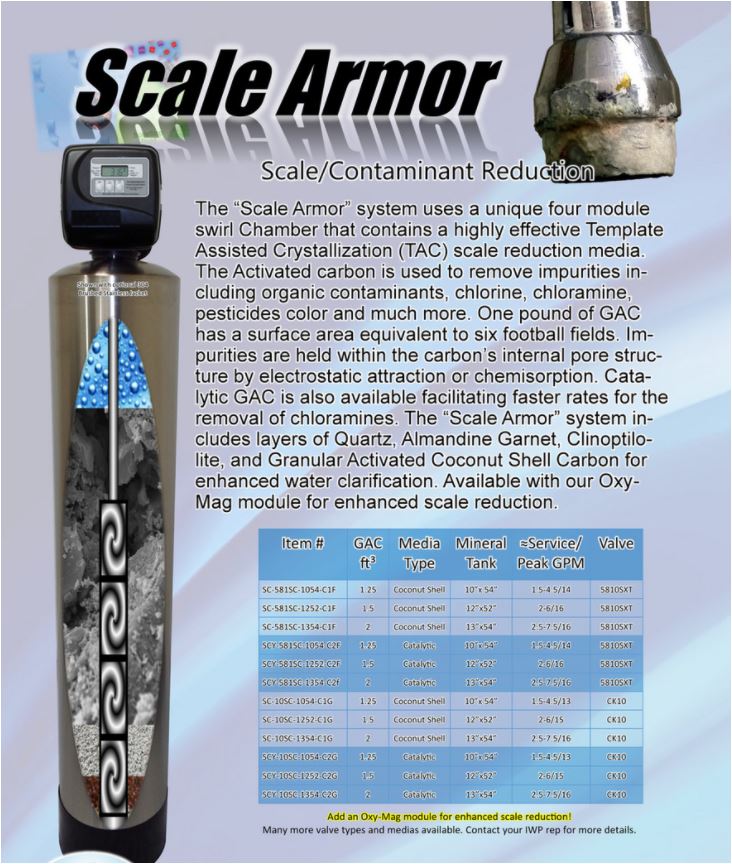
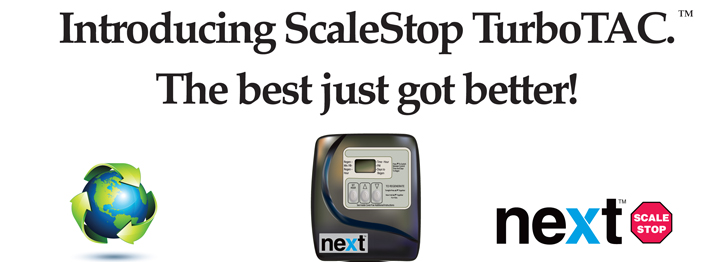
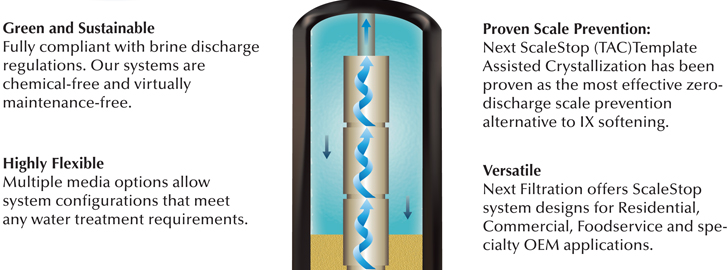
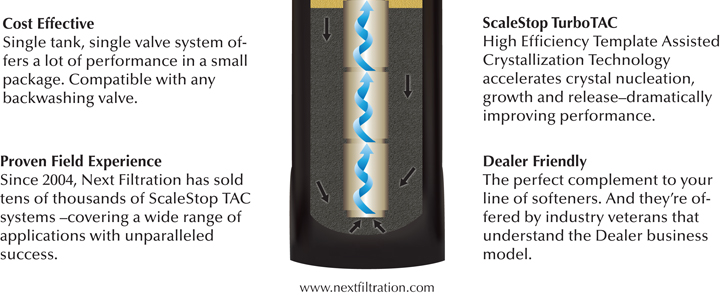
#152


